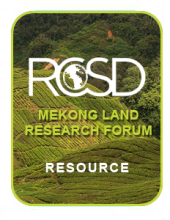Land Library
Bienvenue dans la bibliothèque du Land Portal. Explorez notre vaste collection de ressources en libre accès (plus de 74 000), comprenant des rapports, des articles scientifiques, des articles de recherche, des publications évaluées par des pairs, des documents juridiques, des vidéos et bien plus encore.
/ library resources
Showing items 1 through 9 of 50.Rural areas in Cambodia have been the target of large-scale land acquisitions since the late 1990s. As of March 2012, economic land concessions in Cambodia covered more than 2 million hectares, equivalent to over half of the country’s arable land.
Increased global demand for land underscores the need for well-designed, country-level land policies to protect long-held rights, facilitate land access, and address constraints to growth. However, reforms are often technically complex, politically sensitive, and time consuming.
ABSTRACTED FROM THE PROGRAM DESCRIPTION: In recent years, various actors, from big foreign and domestic corporate business and finance to governments, have initiated a large-scale worldwide enclosure of agricultural lands, mostly in the Global South but also elsewhere.
ABSTRACTED FROM WEB INTRODUCTION AND EXECUTIVE SUMMARY: In order to inform Myanmar’s first multi-stakeholder national dialogue workshop on land tenure and user rights (held November 24th & 25th, 2012), Forest Trend’s Senior Law & Policy Advisor Rob Oberndorf was asked to conduct an in-dep
Through LMAP, and subsequent LASSP, Cambodia has made impressive progress in building a functioning cadastral system over the last ten years.
This paper uses four years of panel data on 793 households collected during 2001–11 to measure chronic poverty in rural Cambodia and to identify its key determinants.
Although Cambodia is one of Asia’s smallest and poorest economies—in the Association of Southeast Asian Nations (ASEAN) only Burma’s per capita purchasing power is lower—changes in its environment for business and trade since the turn of the millennium have been rapid and dramatic.
Cambodia is highly dependent on agriculture: the agricultural sector is responsible for more than 30 percent of GDP and provides employment for more than 70 percent of people who are employed (ADB 2011).
The author argues that the democratic reform in Myanmar is rooted in profound internal and external factors. Since the beginning of the reform, the changes in Myanmar have taken tolls in a series of China’s existing interests inside the country.

